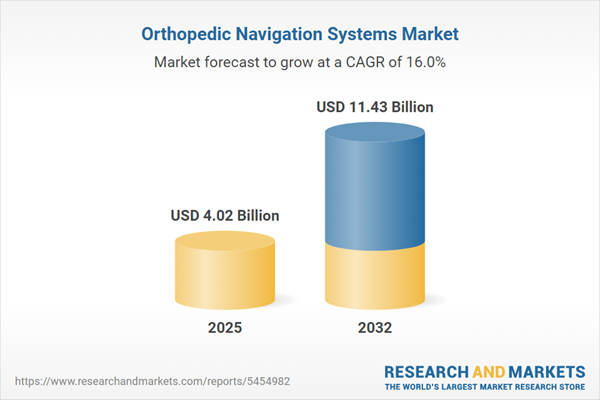Speak directly to the analyst to clarify any post sales queries you may have.
The orthopedic navigation systems market is entering a phase of robust innovation and adoption, propelled by the drive for greater surgical accuracy and integrated clinical workflows. Senior decision-makers are increasingly focused on solutions that enable precision, efficiency, and adaptability across orthopedic procedures and care environments.
Market Snapshot: Orthopedic Navigation Systems Market Growth
The orthopedic navigation systems market grew from USD 3.48 billion in 2024 to USD 4.02 billion in 2025. It is expected to continue expanding at a CAGR of 16.03%, reaching USD 11.43 billion by 2032. These figures reflect the sector’s momentum, fueled by expanding procedure volumes, evolving technologies, and greater demand for enhanced surgical outcomes.
Scope & Segmentation
This research offers a comprehensive analysis of the orthopedic navigation systems market, focusing on actionable segmentation insights for strategic planning:
- Applications:
- Joint Replacement, including Hip, Knee, and Shoulder Replacement
- Spinal Surgery
- Trauma Surgery
- Technologies:
- Electromagnetic Navigation
- Optical Navigation
- End Users:
- Ambulatory Surgical Centers
- Hospitals
- Orthopedic Clinics
- Components:
- Accessories (Instruments, Markers)
- Hardware (Navigation Console, Patient Tracking Tools, Tracking Cameras)
- Services (Installation, Maintenance, Training)
- Software (Imaging, Planning, Registration Software)
- Regions:
- Americas (North America – United States, Canada, Mexico; Latin America – Brazil, Argentina, Chile, Colombia, Peru)
- Europe, Middle East & Africa (Europe – United Kingdom, Germany, France, Russia, Italy, Spain, Netherlands, Sweden, Poland, Switzerland; Middle East – United Arab Emirates, Saudi Arabia, Qatar, Turkey, Israel; Africa – South Africa, Nigeria, Egypt, Kenya)
- Asia-Pacific (China, India, Japan, Australia, South Korea, Indonesia, Thailand, Malaysia, Singapore, Taiwan)
- Companies:
- Stryker Corporation
- DePuy Synthes, Inc.
- Zimmer Biomet Holdings, Inc.
- Medtronic plc
- Smith & Nephew plc
- Brainlab AG
- Materialise NV
- NuVasive, Inc.
- Medacta International SA
- OrthAlign, Inc.
Key Takeaways for Strategic Decision-Makers
- Orthopedic navigation systems are accelerating the shift toward minimally invasive, digitally guided interventions, resulting in more consistent outcomes and enhanced operating room workflow integration.
- Joint replacement, particularly for hip, knee, and shoulder procedures, remains the leading application, while adoption in spinal and trauma surgeries continues to rise.
- Convergence between advanced imaging, robotics, and real-time analytics is transforming these platforms from stand-alone tools to core elements of surgical ecosystems.
- Hospitals are primary early adopters due to larger case volumes and budgets, but ambulatory surgical centers and clinics are becoming key growth drivers—expanding market reach and procedural efficiency.
- Providers, manufacturers, and suppliers are building dynamic partnerships and open-architecture platforms to ensure flexibility, interoperability, and ongoing innovation through collaboration.
- The market’s competitive landscape is marked by strategic alliances, geographic expansion, and an increasing emphasis on training and outcome-based value demonstration.
Tariff Impact: Navigating New US Import Duties
Recent implementation of United States tariffs on medical device imports is impacting the orthopedic navigation systems market by introducing new supply chain complexities and cost pressures. Stakeholders are diversifying sourcing strategies, exploring near-shoring alternatives, and leveraging group purchasing to offset additional costs. These shifts require agile procurement, greater value engineering, and strong cross-industry collaboration to ensure supply continuity and mitigate downstream impacts on clinical investments.
Methodology & Data Sources
This analysis utilizes extensive primary research, including interviews with orthopedic surgeons, engineers, and administrators across major global regions. Secondary research synthesizes data from peer-reviewed publications, regulatory reports, annual reports, clinical trial registries, and patent databases. Robust triangulation and scenario analysis reinforce accuracy and strategic relevance.
Why This Report Matters
- Equips executive teams with a granular understanding of evolving technologies, key growth segments, and emerging regional opportunities within the orthopedic navigation systems market.
- Provides strategic insights into market entry, competitive positioning, and risk mitigation—including regulatory and supply chain considerations.
- Supports evidence-based investment, procurement, and development decisions to sustain profitability and competitive edge in a dynamic surgical technology landscape.
Conclusion
Executive teams leveraging this research will be positioned to drive operational efficiency, capitalize on emerging opportunities, and lead innovation within the orthopedic navigation ecosystem. The evolving market landscape demands informed, agile strategic action for sustained growth and differentiation.
Additional Product Information:
- Purchase of this report includes 1 year online access with quarterly updates.
- This report can be updated on request. Please contact our Customer Experience team using the Ask a Question widget on our website.
Table of Contents
3. Executive Summary
4. Market Overview
7. Cumulative Impact of Artificial Intelligence 2025
Companies Mentioned
The companies profiled in this Orthopedic Navigation Systems market report include:- Stryker Corporation
- DePuy Synthes, Inc.
- Zimmer Biomet Holdings, Inc.
- Medtronic plc
- Smith & Nephew plc
- Brainlab AG
- Materialise NV
- NuVasive, Inc.
- Medacta International SA
- OrthAlign, Inc.
Table Information
| Report Attribute | Details |
|---|---|
| No. of Pages | 199 |
| Published | October 2025 |
| Forecast Period | 2025 - 2032 |
| Estimated Market Value ( USD | $ 4.02 Billion |
| Forecasted Market Value ( USD | $ 11.43 Billion |
| Compound Annual Growth Rate | 16.0% |
| Regions Covered | Global |
| No. of Companies Mentioned | 11 |









